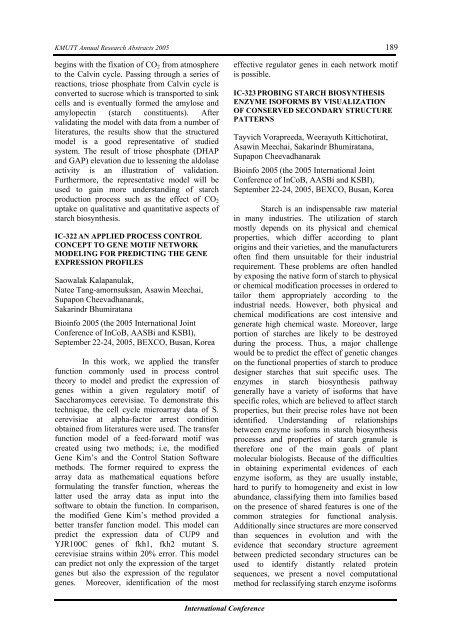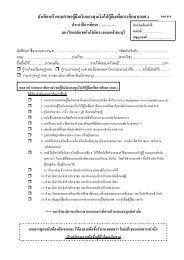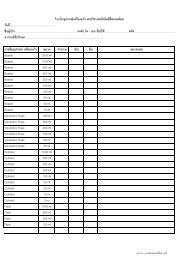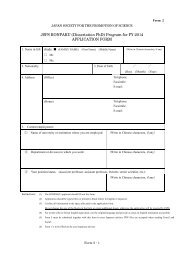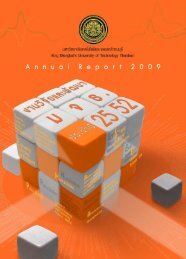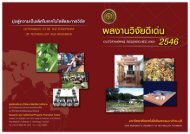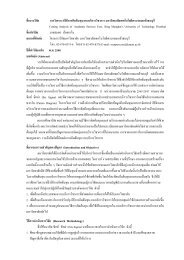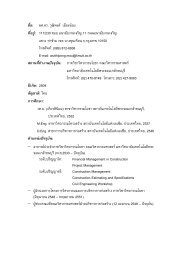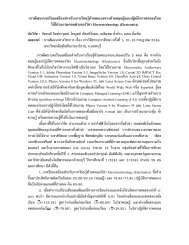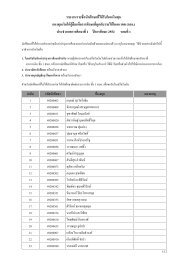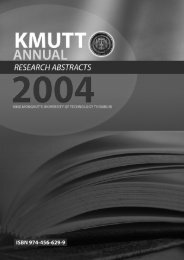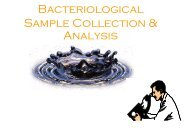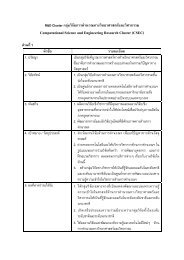You also want an ePaper? Increase the reach of your titles
YUMPU automatically turns print PDFs into web optimized ePapers that Google loves.
KMUTT Annual Research Abstracts 2005<br />
begins with the fixation of CO 2 from atmosphere<br />
to the Calvin cycle. Passing through a series of<br />
reactions, triose phosphate from Calvin cycle is<br />
converted to sucrose which is transported to sink<br />
cells and is eventually formed the amylose and<br />
amylopectin (starch constituents). After<br />
validating the model with data from a number of<br />
literatures, the results show that the structured<br />
model is a good representative of studied<br />
system. The result of triose phosphate (DHAP<br />
and GAP) elevation due to lessening the aldolase<br />
activity is an illustration of validation.<br />
Furthermore, the representative model will be<br />
used to gain more understanding of starch<br />
production process such as the effect of CO 2<br />
uptake on qualitative and quantitative aspects of<br />
starch biosynthesis.<br />
IC-322 AN APPLIED PROCESS CONTROL<br />
CONCEPT TO GENE MOTIF NETWORK<br />
MODELING FOR PREDICTING THE GENE<br />
EXPRESSION PROFILES<br />
Saowalak Kalapanulak,<br />
Natee Tang-amornsuksan, Asawin Meechai,<br />
Supapon Cheevadhanarak,<br />
Sakarindr Bhumiratana<br />
Bioinfo 2005 (the 2005 International Joint<br />
Conference of InCoB, AASBi and KSBI),<br />
September 22-24, 2005, BEXCO, Busan, Korea<br />
In this work, we applied the transfer<br />
function commonly used in process control<br />
theory to model and predict the expression of<br />
genes within a given regulatory motif of<br />
Saccharomyces cerevisiae. To demonstrate this<br />
technique, the cell cycle microarray data of S.<br />
cerevisiae at alpha-factor arrest condition<br />
obtained from literatures were used. The transfer<br />
function model of a feed-forward motif was<br />
created using two methods; i.e, the modified<br />
Gene Kim’s and the Control Station Software<br />
methods. The former required to express the<br />
array data as mathematical equations before<br />
formulating the transfer function, whereas the<br />
latter used the array data as input into the<br />
software to obtain the function. In comparison,<br />
the modified Gene Kim’s method provided a<br />
better transfer function model. This model can<br />
predict the expression data of CUP9 and<br />
YJR100C genes of fkh1, fkh2 mutant S.<br />
cerevisiae strains within 20% error. This model<br />
can predict not only the expression of the target<br />
genes but also the expression of the regulator<br />
genes. Moreover, identification of the most<br />
189<br />
effective regulator genes in each network motif<br />
is possible.<br />
IC-323 PROBING STARCH BIOSYNTHESIS<br />
ENZYME ISOFORMS BY VISUALIZATION<br />
OF CONSERVED SECONDARY STRUCTURE<br />
PATTERNS<br />
Tayvich Vorapreeda, Weerayuth Kittichotirat,<br />
Asawin Meechai, Sakarindr Bhumiratana,<br />
Supapon Cheevadhanarak<br />
Bioinfo 2005 (the 2005 International Joint<br />
Conference of InCoB, AASBi and KSBI),<br />
September 22-24, 2005, BEXCO, Busan, Korea<br />
Starch is an indispensable raw material<br />
in many industries. The utilization of starch<br />
mostly depends on its physical and chemical<br />
properties, which differ according to plant<br />
origins and their varieties, and the manufacturers<br />
often find them unsuitable for their industrial<br />
requirement. These problems are often handled<br />
by exposing the native form of starch to physical<br />
or chemical modification processes in ordered to<br />
tailor them appropriately according to the<br />
industrial needs. However, both physical and<br />
chemical modifications are cost intensive and<br />
generate high chemical waste. Moreover, large<br />
portion of starches are likely to be destroyed<br />
during the process. Thus, a major challenge<br />
would be to predict the effect of genetic changes<br />
on the functional properties of starch to produce<br />
designer starches that suit specific uses. The<br />
enzymes in starch biosynthesis pathway<br />
generally have a variety of isoforms that have<br />
specific roles, which are believed to affect starch<br />
properties, but their precise roles have not been<br />
identified. Understanding of relationships<br />
between enzyme isofoms in starch biosynthesis<br />
processes and properties of starch granule is<br />
therefore one of the main goals of plant<br />
molecular biologists. Because of the difficulties<br />
in obtaining experimental evidences of each<br />
enzyme isoform, as they are usually instable,<br />
hard to purify to homogeneity and exist in low<br />
abundance, classifying them into families based<br />
on the presence of shared features is one of the<br />
common strategies for functional analysis.<br />
Additionally since structures are more conserved<br />
than sequences in evolution and with the<br />
evidence that secondary structure agreement<br />
between predicted secondary structures can be<br />
used to identify distantly related protein<br />
sequences, we present a novel computational<br />
method for reclassifying starch enzyme isoforms<br />
International Conference


